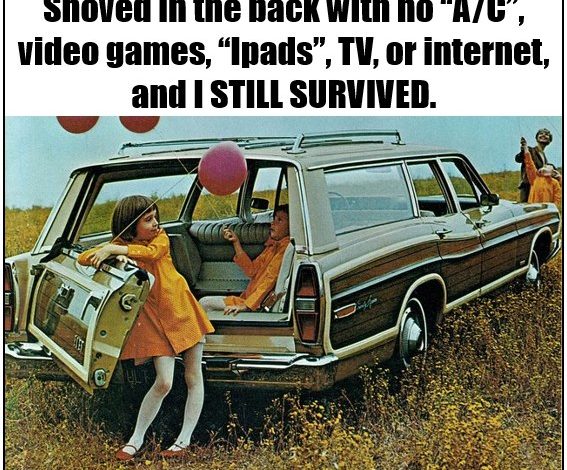
ADVERTISEMENT
Surviving the Backseat: A Nostalgic Look at Road Trips Before Technology
ADVERTISEMENT
Introduction
For many who grew up in the 60s, 70s, or 80s, road trips were a rite of passage. Family vacations meant piling into the backseat of a station wagon or van, without air conditioning, video games, or even seatbelts in some cases. Entertainment options were limited to the scenery outside the window, a handful of books or toys, and games like “I Spy.” And yet, despite the lack of digital distractions, those long drives hold a special place in the memories of many. Let’s take a nostalgic journey back to those days of simpler, unplugged travel and explore why those backseat experiences are fondly remembered today.
1. The Classic Station Wagon: A Symbol of Family Adventures
The station wagon was a staple of family life in the mid-20th century. With its expansive backseat area and rear-facing third row, it was the quintessential road-trip vehicle, designed to transport large families comfortably across long distances. These cars weren’t just vehicles; they were mini homes on wheels, complete with blankets, snacks, and plenty of room to stretch out (or argue with siblings).
The back of the station wagon became a playground of sorts, with kids lying down, playing games, or simply watching the world go by through the rear window. Without the strict seatbelt laws of today, kids often had the freedom to roam within the car, creating their own little world in the back. In a time before SUVs, the station wagon offered both function and fun, making it an icon of family travel.
ADVERTISEMENT
2. Surviving the Heat: Life Without Air Conditioning
Many station wagons of the era lacked air conditioning, especially in the rear seats, which could make summer road trips uncomfortable. Windows would be rolled down, allowing the hot wind to whip through the car, a far cry from today’s climate-controlled vehicles. Cooling off meant stopping at a gas station to grab a cold soda or popsicle or finding a shady spot to take a break.
Kids adapted to the heat by wearing lighter clothes, wetting washcloths for their foreheads, or simply enduring it as part of the adventure. The lack of A/C taught resilience and made the occasional stop at a roadside diner or ice cream stand all the more enjoyable. The discomfort of the heat became just another part of the journey, something to laugh about in retrospect.
3. Entertaining Ourselves: Games, Imagination, and the Art of Boredom
Without tablets, phones, or portable video games, kids had to rely on their own creativity to pass the time. Car games like “I Spy,” “20 Questions,” and “License Plate Bingo” became classics for a reason—they turned the journey itself into a source of entertainment. Each game was a way for kids to interact with their surroundings and each other, turning the hours spent on the road into a shared experience.
ADVERTISEMENT
Books, comics, and sketchpads were also popular car companions. Kids who were lucky enough to have a portable radio or Walkman (when it finally became available) could listen to music, but for most, entertainment meant engaging with siblings or using their imaginations. The experience of boredom, something modern kids encounter less frequently, pushed young travelers to be creative, resourceful, and adaptable.
4. The Family Bonding Experience: Sibling Rivalries and Shared Memories
Road trips in the station wagon weren’t just about reaching the destination; they were about family bonding, for better or worse. With limited space, kids learned to share, compromise, and occasionally squabble with each other. Parents enforced rules, set up makeshift barriers between feuding siblings, and came up with creative punishments and rewards to keep the peace.
For many families, these road trips became a defining part of childhood, creating memories that outlasted the destinations themselves. Kids remembered the funny moments, the sibling antics, and even the arguments. The shared experience of being “shoved in the back” became a nostalgic symbol of family life, where everyone was in it together, navigating the ups and downs of travel as a team.
5. The Scenic Route: A Journey Through America’s Back Roads
ADVERTISEMENT
Long road trips in the era before GPS often meant taking scenic routes or getting a bit lost. Families would pass through small towns, fields, forests, and landmarks, experiencing the diversity of landscapes and local culture along the way. Each stop at a roadside attraction, quirky diner, or scenic lookout added character to the journey. Kids would marvel at giant statues, quirky signs, and the changing scenery, often marking the passing states with pride.
Without smartphones or digital distractions, kids were more in tune with their surroundings, taking in the countryside and observing the world beyond the car window. The journey itself was a chance to see parts of the country that air travel often skips. Today, this kind of road-tripping has become rare, replaced by more direct and efficient forms of travel, but for many, the scenic routes remain a cherished memory.
6. No Seatbelts, No Worries? A Different Time for Safety
In a world with strict seatbelt and child-safety laws, it’s hard to imagine a time when kids piled into the back of a station wagon without a second thought about seatbelts. During these road trips, safety looked very different. Kids would often move around freely, stretching out on the floor, leaning on each other, or lying down in the rear area. Parents would improvise to keep kids secure, but it was largely a more relaxed approach to safety.
While modern vehicles and laws have greatly improved travel safety, this freedom contributed to the sense of adventure and wonder that defined these road trips. For better or worse, the lack of strict regulations gave kids a feeling of autonomy and made the car feel like a personal playground. These days, the memory of those free-spirited rides can evoke a mix of nostalgia and disbelief.
7. The Joy of Analog Life: No Screens, No Internet, Just Family
Perhaps the most striking aspect of these road trips was the lack of technology. There were no screens to distract, no Wi-Fi to connect to, and no instant entertainment options. Kids weren’t constantly plugged in, which meant they had to rely on each other and their surroundings for amusement.
This analog way of traveling forced families to interact in ways that are often lost today. Parents shared stories, siblings created inside jokes, and everyone experienced the full spectrum of the journey together, without the isolating effect of personal screens. In a way, the absence of technology allowed for a richer, more immersive travel experience, where everyone was present, in the moment, and connected to each other.
Conclusion
ADVERTISEMENT
Road trips in the family station wagon were an experience that many look back on with nostalgia, a reminder of a time when travel was as much about the journey as it was about the destination. Shoved into the back without air conditioning or electronic entertainment, kids learned to endure discomfort, appreciate simple pleasures, and find joy in shared family moments. These trips taught resilience, creativity, and patience, and they built memories that continue to bring a smile to those who lived through them.
Today, as we navigate a world of instant entertainment and climate-controlled vehicles, the simplicity of those station wagon days serves as a reminder that sometimes, the best memories are made when we unplug, step away from comfort, and embrace the adventure of the open road. For those who experienced it, these trips are more than just stories—they’re a part of who they are, a nostalgic reminder that yes, they survived, and they wouldn’t have had it any other way.




